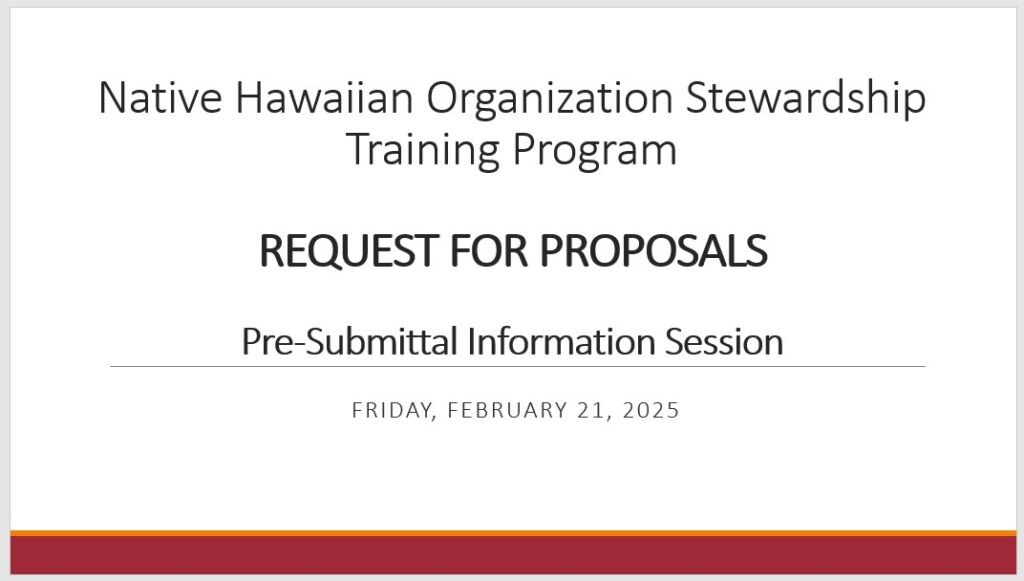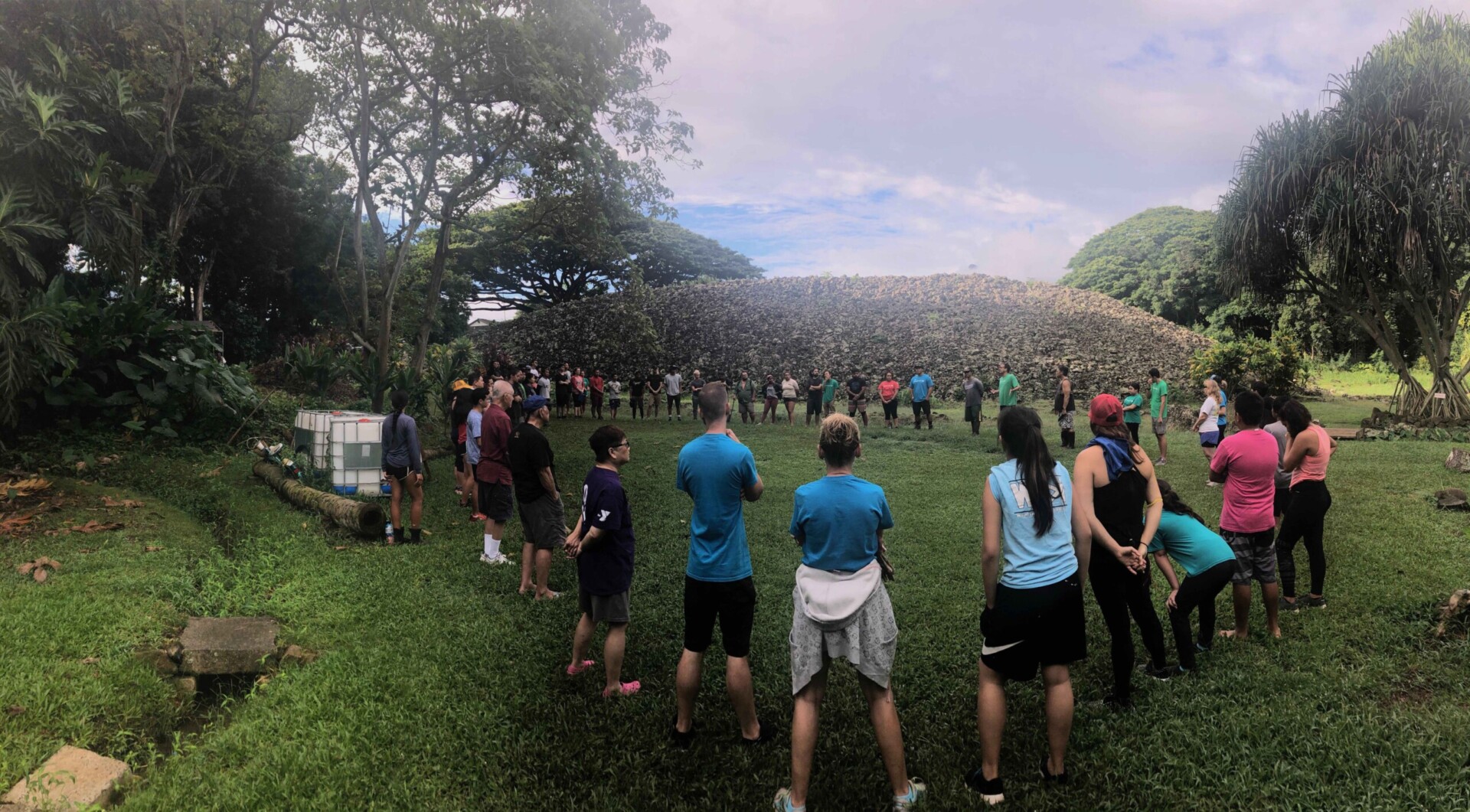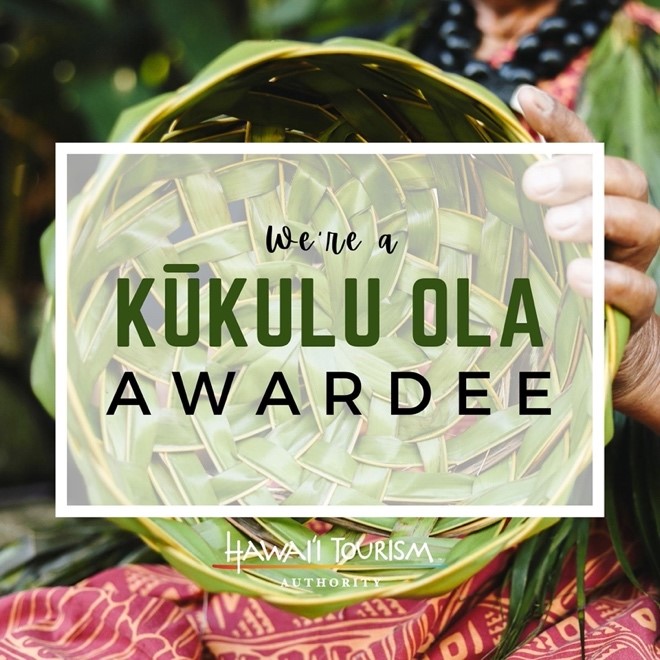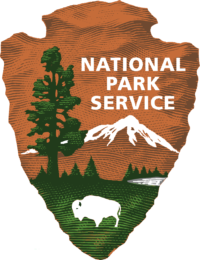REQUEST FOR PROPOSALS
DEADLINE: March 19, 2025, 11:59 p.m.
1/24/2025: The NHO Stewardship Training Request for Proposals (RFP) is an open call for eligible Native Hawaiian Organizations to propose a hands-on stewardship training project at a specific historic or cultural property in the Hawaiian Islands. Potential outcomes and benefits include identification, documentation, evaluation and preservation of historic and culturally-significant properties by means of training workshops, field schools, symposia or training sessions to address specific identified preservation needs. Funding is provided through a partnership agreement between the NHO and Historic Hawai’i Foundation in accordance with approved budgets for selected projects. Funding is anticipated to be in the range of $25,000 to $50,000 for each selected training project.
The NHO Stewardship Training Program Committee will evaluate NHO proposals according to pre-established criteria. The highest-ranked NHOs will be offered a partnership agreement with HHF to implement their proposed stewardship training activity. The final number of selected NHOs will be determined by the funding available for 2025. Publication of this RFP does not obligate HHF to award any specific contract or to obligate all or any part of the available funds.
VIRTUAL INFORMATION SESSION
A free virtual information session designed to assist potential applicants in completing the 2025 NHO Stewardship Training Program RFP Form was held on Friday, February 21, 2025.
CLICK THE IMAGE AT LEFT TO VIEW THE INFORMATION SESSION SLIDE DECK
QUESTIONS AND ANSWERS FROM THE PRE-SUBMITTAL INFORMATION SESSION
February 21, 2025
Note: Questions and Answers have been edited for length and clarity.
Answer: It depends. It’s not a specific requirement to engage native Hawaiians. However, if your project involves regulatory compliance under the National Historic Preservation Act, Section 106 and consulting under Chapter 6-E at the State level, it may involve consulting with the native Hawaiian community. Historic Hawai‘i Foundation and Office of Native Hawaiian Relations can provide technical assistance and work with you on that.
The intention of the funding is for Native Hawaiian organizations and community to be able to share their culture, in this case, historic properties, in a way that is respectful and meaningful. If the proposed site allows for and is appropriate for visitors in general it is fine to include non-Hawaiian visitors to participate in the training and stewardship activities. For this program, “visitor” means those people coming to the site to engage with the site. This could include kama‘āina, school groups, cultural practitioners, community members and tourists. It really depends upon the site and the stewardship activities at the site.
Answer: The NATIVE Act requires a visitation component but that doesn’t necessarily mean a visitor from outside of Hawai‘i. Visitors could be local residents who are new to the site, coming for an educational opportunity, they could be a school group, or a volunteer group coming to do some type of restoration work. The educational activity could be an orientation, protocol, or cultural awareness training—any means of engaging people and bringing them to the place to learn about and contribute to its stewardship.
An important aspect of the visitor requirement is access. The Historic Property Information Section of the RFP form asks, “Is the Property open/accessible to the public,” and one of the answer options is “sometimes.” That could mean the site is open for seasonal activities, or available to people who have a reason to be there but not to the general public. If the site is in a State Park then it’s available to anyone comes but if it’s only available to people for a specific purpose, your proposal should describe who has access, when, and under what circumstances. This would not be appropriate for, say, a family cemetery in the backyard of a private home that is only accessible to ‘ohana. That would be a very legitimate stewardship activity but if it is not accessible to anyone else this program would not be the right fit. Your site should provide some kind of access for people to learn through hands-on experience and in-person engagement.
Answer: The project site does not need to be listed on the Hawaii State or National Register of Historic Places to qualify for this program. It could be a site that is eligible for the National Register but not necessarily listed. The location does need to be a place, a physical, tangible location. This could include a site, a building, a structure, a district or a landscape. The location also must hold significance to the history, culture, traditions, practices, and or customs of Native Hawaiian organizations and communities.
Answer: Yes, providing they hold historical and/or cultural significance to Native Hawaiians. The project site may be pre- or post-contact with either archaeological and/or architectural features.
Answer: If your project is awarded, you will receive one year of funding and have one year to move through the process from fulfilling compliance requirements through to project completion on or before June 2026.
Answer: That would depend on how you frame your project and what it is you want to do in in terms of conservation or preservation of the iwi kūpuna. If the proposed project is to preserve and educate at a location that includes burials, including managed access, that could be considered. The proposal should clearly describe the overall historic property, the stewardship needs, the educational component and how visitor access is provided. This program is about visitation and education which involves bringing people into that space or providing public access, but that may not be culturally appropriate in some circumstances.
The required components of this program are a Native Hawaiian Organization, a historic property, preservation need, education, and visitation. Your proposal must demonstrate all five of those to be eligible, and if education and access become a barrier then this is probably not the funding mechanism for that project. Tourism or even just Community Access or School groups might be inappropriate for burial or iwi kūpuna stewardship projects.
Answer: No. Because the Partnership Agreements are with HHF and not directly with the National Park Service (NPS), the only thing we need is your Federal Employer Identification number or FEIN. You provide documentation of your FEIN with your W-9, which is one of the required uploads that must be submitted with your proposal form.
Answer: The indirect expenses for the organization are capped at 10% of your budget, so that applies to general overhead and regular operation expenses for your NHO, but you can break out the directly-related program activities. You can include line items for staff and personnel costs for the project; line items for things like Insurance, especially if you’re having work days or people coming to the site to participate in activities; you can include the cost of materials and equipment; instructor fees, if you need to hire a kumu to come and talk about how to engage in cultural practices at the site or if you want to provide a stipend, you can include that. You really need to think about what it takes to do this kind of activity, break it down as specifically as you can, and include that breakdown in your budget. Just keep in mind that any general overhead costs must be less than 10% of your total project budget.
Answer: Yes, if the previous project is complete and you are proposing a different activity. If you have an open or incomplete project that was funded through this program then, no, your project must be complete. Once you have delivered your final report and closed out the partnership agreement, then you can reapply for expanding or adding to the project, building on your previous work, but it cannot be identical to what you already did.
Answer: Yes, that would be an allowed line item because this is an education program to provide hands-on stewardship training. If program participants are summer interns, emerging professionals, or people who are doing this part time in addition to work or school—absolutely. We want to encourage that kind of participation from young people, lifelong learners and students of all ages so that would be appropriate here.
Answer: Yes, you can include contractor fees. That could include labor, materials, service—and not only for archaeological firms. Contractors could include cultural monitors, field crews, or another type of professional services your project requires.
PROGRAM BACKGROUND
In 2022, Historic Hawai‘i Foundation launched a new program to partner with Native Hawaiian Organizations on hands-on stewardship training for the preservation of historic and cultural sites that are significant to Native Hawaiian organizations and communities. The agreement supports building the capacity of NHOs towards historic preservation and stewardship with the goal of ensuring that their traditional cultural stories and places are being documented, preserved and shared in an appropriate manner with visitors and residents alike.
The five-year program is the result of a partnership with the U.S. Department of the Interior’s National Park Service and Office of Native Hawaiian Relations, with funding through the Bureau of Indian Affairs. In September 2021, NPS added $450,000 to HHF’s on-going project for Historic Preservation Training in the Hawaiian Islands. The additional funds were provided through the Native American Tourism & Improving Visitor Experience (NATIVE) Act that was passed by Congress in 2016 to establish a more inclusive national travel and tourism strategy with the potential to deliver significant benefits for Native Hawaiians, including jobs creation, elevated living standards and expanded economic opportunities.
The training units will be implemented in partnership with the Native Hawaiian Organizations (NHO) for preservation of the selected cultural sites. Field work at their respective historic sites to preserve and restore places that are significant to the culture, traditions, and practices of the Native Hawaiian Community will be included.
The selection process began in 2021 with initial program scoping and a development phase to establish NHO solicitation parameters, evaluation criteria, and regulatory compliance requirements. The first NHO solicitation, review and selection of the first three projects took place in 2022. The second solicitation was issued in 2024 and three additional projects were selected. NHO Partners from across the State will be engaged through 2026.
In the news…
Hawaii Public Radio’s Culture & Arts Reporter, Jayna Omaye, talks to NHO program stewards.
Listen (3:11)







